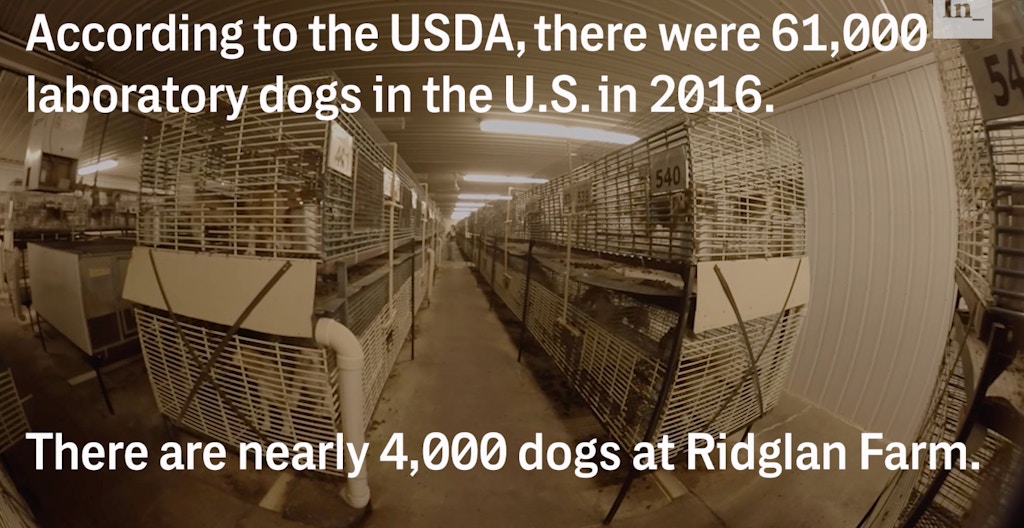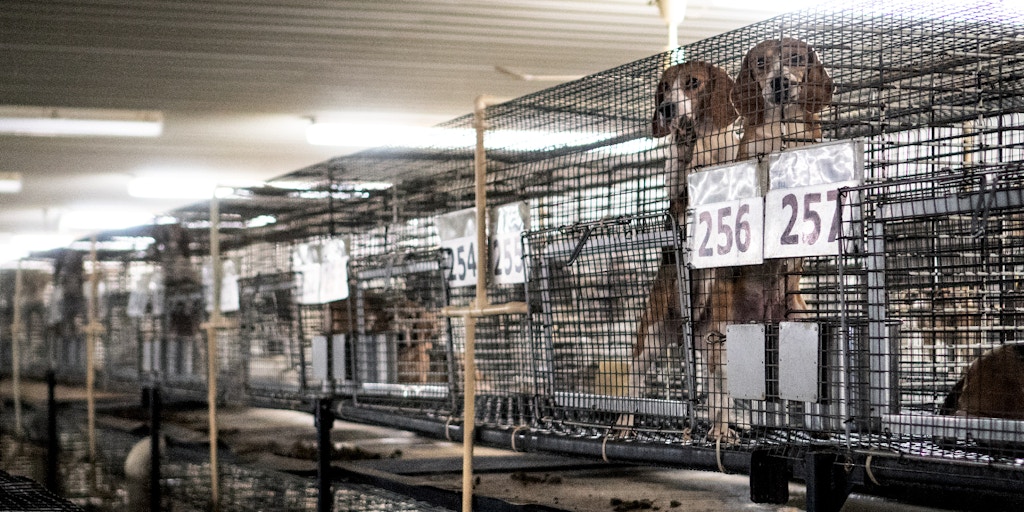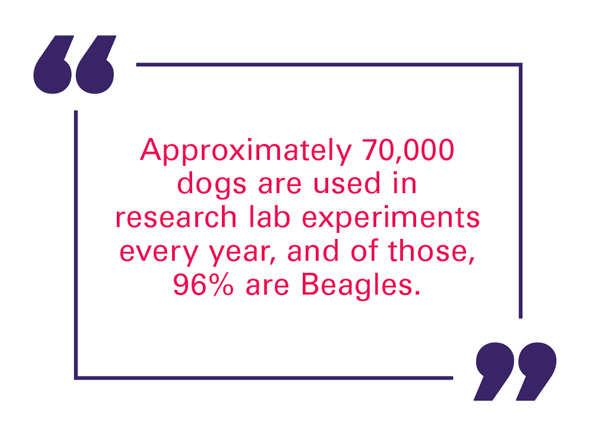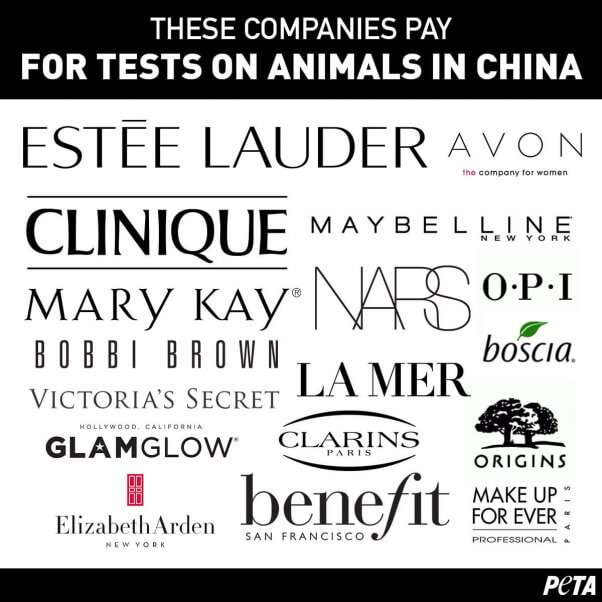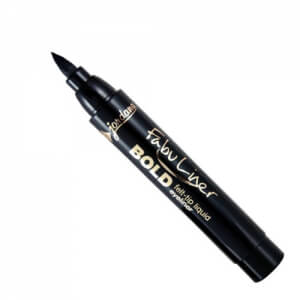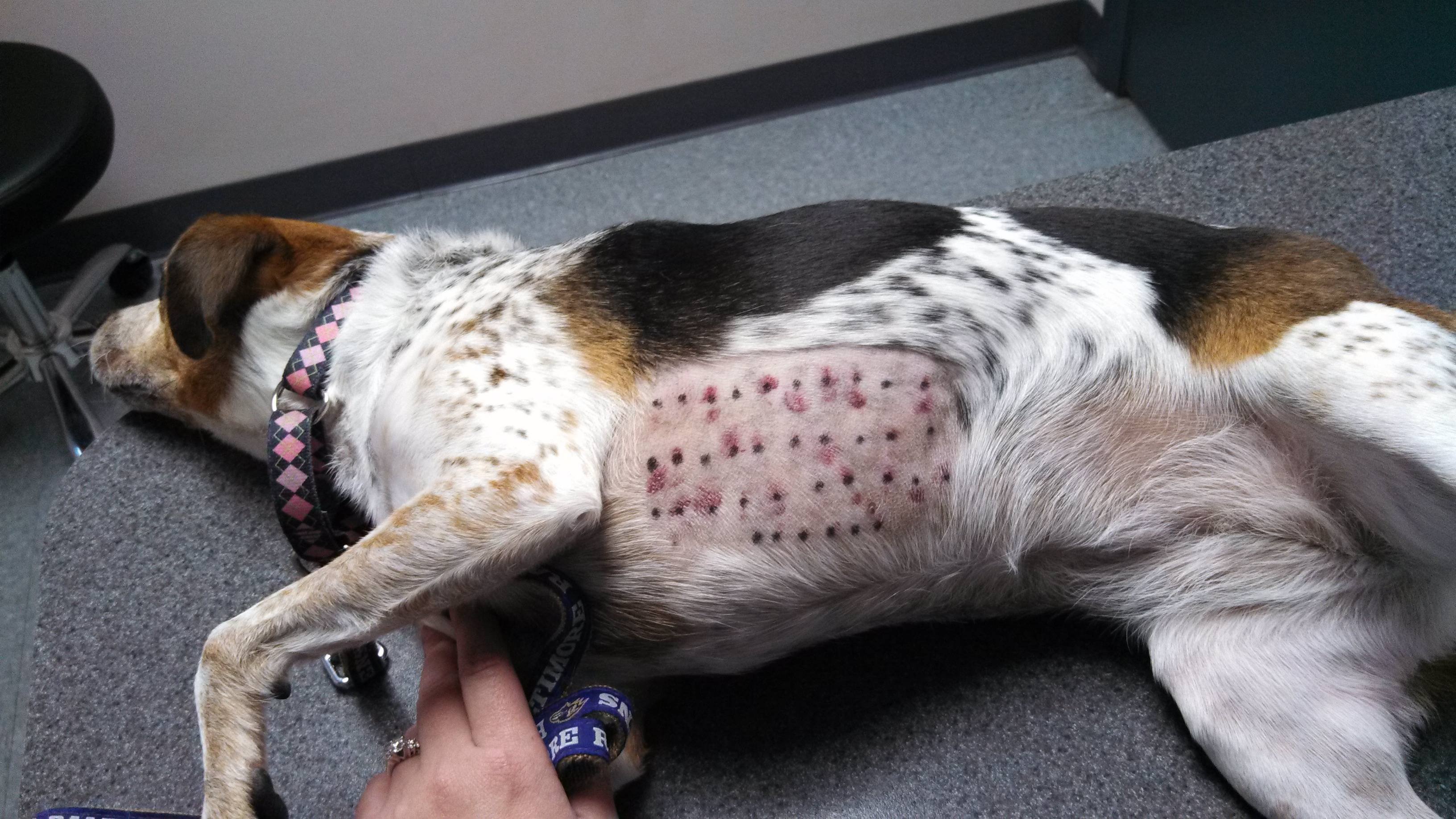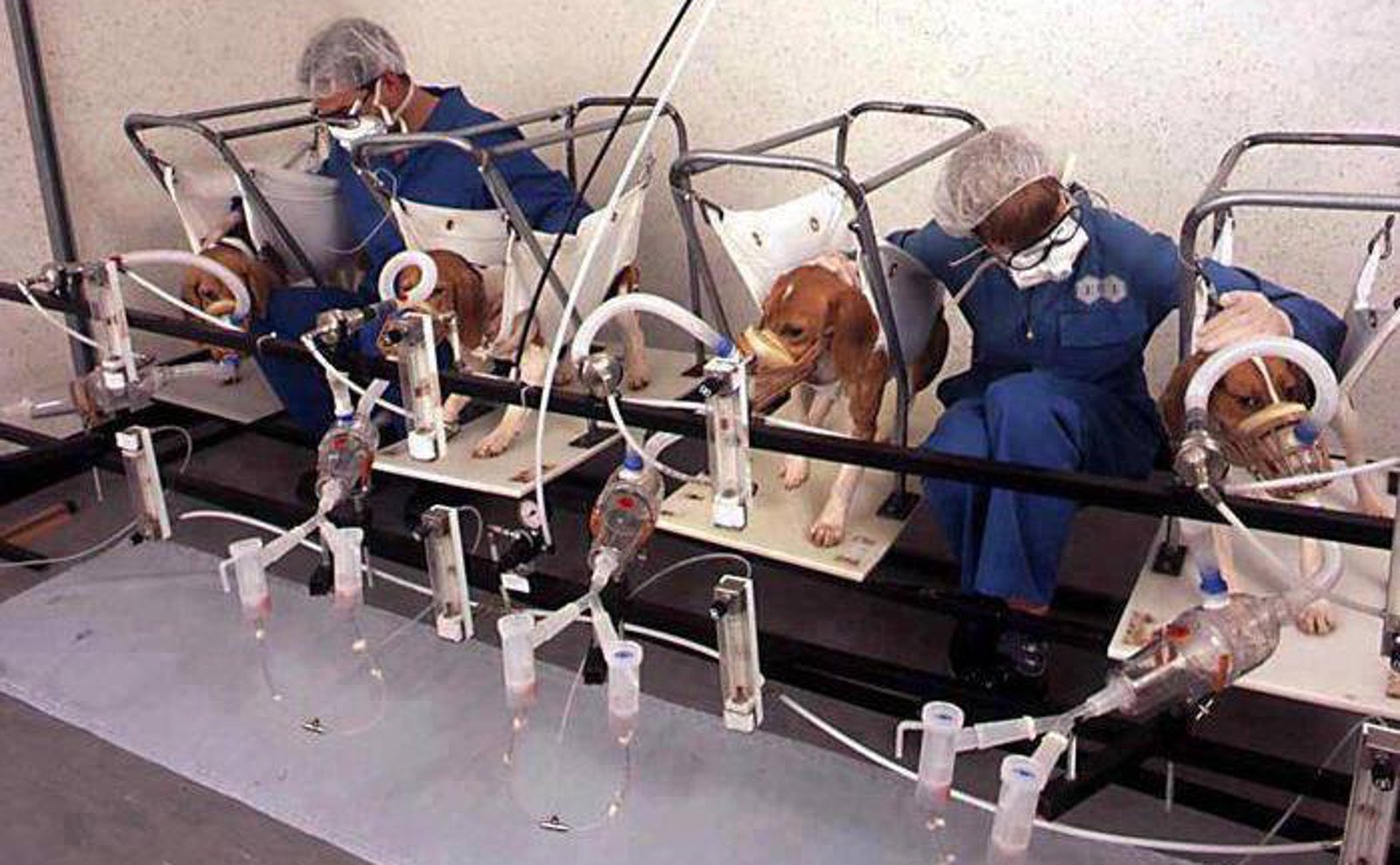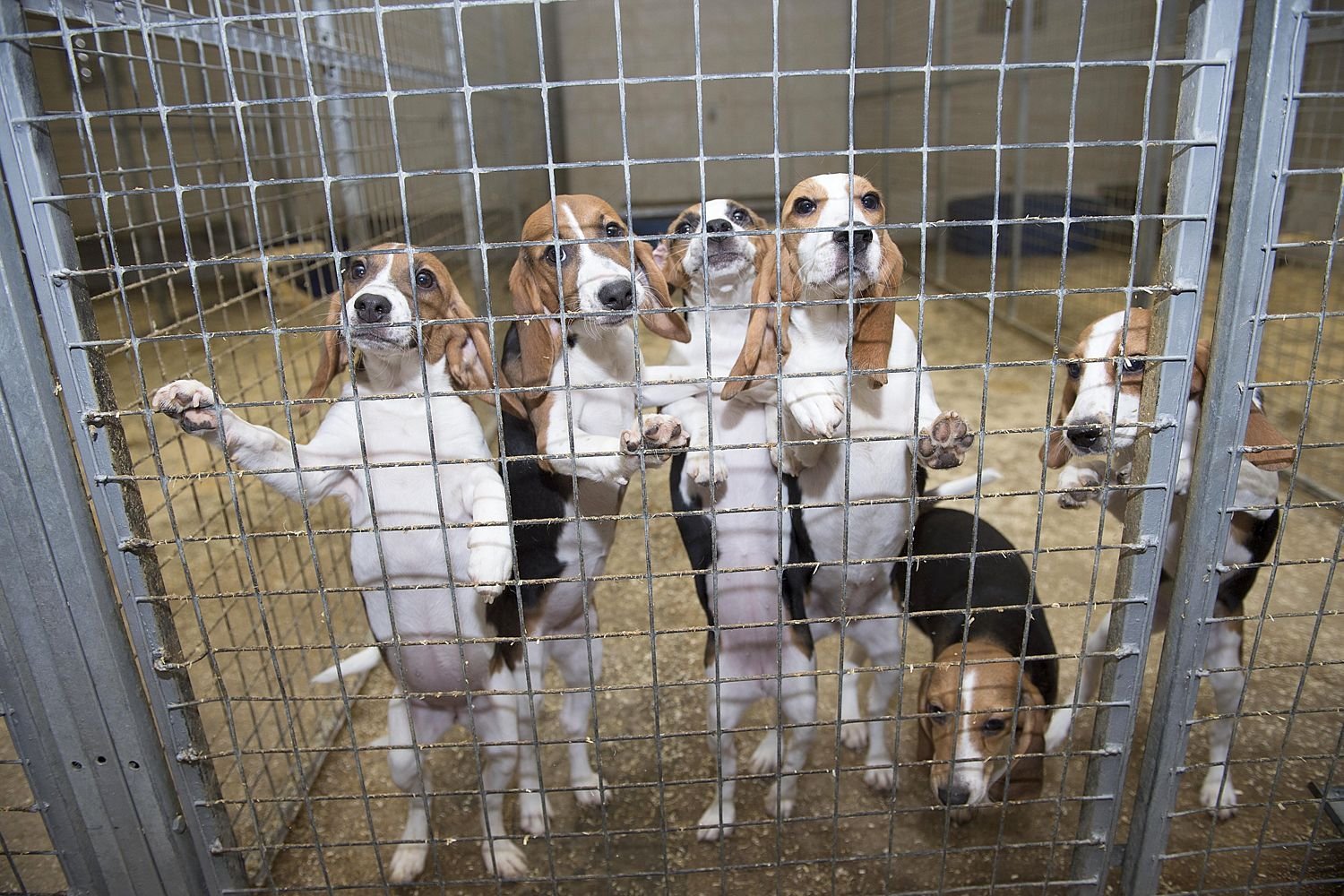https://theintercept.com/2018/05/17/inside-the-barbaric-u-s-industry-of-dog-experimentation/
By Glenn Greenwald, Leighton Akio Woodhouse
THERE IS A largely hidden, poorly regulated, and highly profitable industry in the United States that has a gruesome function: breeding dogs for the sole purpose of often torturous experimentation, after which the dogs are killed because they are no longer of use.
Americans frequently express horror at festivals in countries such as China and South Korea where dogs are killed, cooked, and eaten. Mainstream media outlets in the U.S. routinely report, with a tone of disgust, on the use of dogs in those countries for food consumption.
But in the U.S. itself, corporations and academic institutions exploit dogs (as well as cats and rabbits) for excruciating experiments that are completely trivial, even useless, and are just as abusive as the practices in Asia that have produced so much moral indignation in the West. These dogs are frequently bred into life for the sole purpose of being laboratory objects, and spend their entire, often short, existence locked in a small cage, subjected to procedures that impose extreme pain and suffering.
The horrors of the dog experimentation industry are on vivid display at Ridglan Farms Inc., a company that provides beagles to research facilities.
According to the U.S. Department of Agriculture’s aptly named the Animal Usage report, 60,979 dogs were used in the U.S. for experimentation in 2016 alone. The reported number of all animals used for experimentation, whose reporting was required, was 820,812. Often, the experimentation has nothing to do with medical research, but rather trivial commercial interests, and in almost all cases, dogs provide little to no unique scientific value. This chart, compiled by Speaking of Research using USDA data, reflects the total numbers of animals used for experimentation in 2016 — an increase of 6.9 percent as compared to the prior year:
Dogs bred into life for use or sale as experimentation objects have all the same emotional complexities, sensations of suffering and deprivation, and inbred need for human companionship as household dogs which are loved as pets and members of the family. Yet the legalized cruelty and torture to which man’s best friend is subjected for profit in the U.S. is virtually limitless.
In fact, the majority of dogs bred and sold for experimentation are beagles, which are considered ideal because of their docile, human-trusting personality. In other words, the very traits that have made them such loving and loyal companions to humans are the ones that humans exploit to best manipulate them in labs.
Even when legal standards are adhered to — and they often are not — the permitted abuse to which these dogs are subjected is horrifying. They are often purposely starved or put into a state of severe thirst to induce behavior they would otherwise not engage in. They are frequently bred deliberately to have crippling, excruciating diseases, or sometimes are brought into life just to have have their organs, eyes, and other body partsremoved and studied as puppies, and then quickly killed.
They are force-fed laundry detergents, pesticides, and industrial chemicals to the point of continuous vomiting and death. They are injected with lethal pathogens such as salmonella or rabies. They have artificial sweetener injected into their veins that causes the dogs’ testicles to shrink before they are killed and exsanguinated. Holes are drilled into their skulls so that viruses can be injected into their brains. And all of that is perfectly legal.
The horrors of the dog experimentation industry are on vivid display at Ridglan Farms Inc., one of the three largest firms in the U.S. that provides beagles to research facilities. Located in Dane County, Wisconsin — on a hill west of Madison — the corporation, according to Direct Action Everywhere, or DxE, investigators, provides dogs to research facilities that include the University of Wisconsin, the University of Minnesota, and various colleges within the University of California system.
Last spring, activists with DxE entered a door that was ajar at the Ridglan facility in order to investigate conditions inside, document what they saw, and rescue a sampling of dogs in particular distress. What they found horrified even these hardened activists, who have seen years worth of severe animal abuse. DxE activists spent a year investigating the facility and the industry its serves, and are releasing their footage and accompanying report for the first time today.
One of the DxE investigators, Wayne Hsiung, told The Intercept, “As you approach the facility, the smell is overwhelming — exactly the same smell from a dog meat slaughterhouse in China.” The first thing the investigators saw upon entering — as demonstrated by the photo at the top of this article — was that “the dogs are housed in huge industrial sheds with massive ventilation fans, very similar to the sheds used in factory farms.” Hsiung, a former lawyer, added in an email:
Thousands of dogs are held in cages, usually 1-2 to a cage and stacked on top of one another, that are about twice the length of the dog’s body. We found no facilities for the dogs to step outside or exercise. The dogs sit on their own feces and urine, unable to escape their own waste. Dogs are routinely so desperate to escape that they slam themselves against the cage walls, desperately stretch their paws through the bars, and sometimes chew on the cages. The screams of the dogs in the facility are so loud that we were forced to yell at one another to communicate, even when we were only a foot away from one another.
In response to multiple requests from The Intercept that included detailed questions about what this story would include, a Ridglan spokesperson said the company would decline to comment.
Cages of “research dogs” stacked on top of each other at Ridglan Farms Inc.
Photo: DxE
Dog experimentation is pervasive
The number of dogs used for experimentation in the U.S. has generally declined some over the past several decades — though it rose again last year — but still remains remarkably high. The most common animals used for testing — mice, fish, and birds — are not covered by any federal regulations or reporting requirements, and thus no precise numbers are known, but estimates vary from 20 million to as many as 100 million.
The primary law governing treatment of animal experimentation is the Animal Welfare Act, or AWA, which was first enacted in 1966 under the name Laboratory Animal Welfare Act. Under all federal law, all forms of experimentation on animals — including on dogs — is legally permissible, even though superior research alternatives (such as stem cell research) are increasingly available. A small handful of states have banned product testing on animals if alternatives are available.
While the AWA permits all animal experimentation, it requires minimal standards of humane treatment for dogs that are bred and sold for experimentation. But even when these rules are complied with, the conditions in which “research dogs” are routinely kept are nothing short of barbaric.
For instance, regulations merely require that the dogs’ cage be six inches taller than their height and six inches longer than their body length. Doubling that size eliminates the requirement to allow the dogs out of their cage at all for exercise.
The cruelty even of treatment that complies with legal standards is illustrated by a handbook from one of the field’s most authoritative researchers. The Laboratory Animal Medicine and Science training program series, developed by the American College of Laboratory Animal Medicine, the handbook is designed to create industry norms. Its author is Jerald Silverman, a leading authority figure in the animal research industry.
The handbook describes the proper methods for putting “ear tattoos” on the dogs for identification and tracking purposes. The first picture below is of a “research dog” kept in a cage that is twice the size required by federal regulations, which means, as Silverman notes, that the exercise requirements for the dog are eliminated. The two images below describe the “humane” way for treating research dogs, and the third relates to tattoos:
That means that tens of thousands of dogs are barely able to move. They are fully isolated, with their metal cages stacked on top of one another. Many “research dogs” never see the sunlight, go outside, or exercise, spending their entire lives locked in a cage.
“Research dogs” in cages at Ridglan Farms Inc.
Photo: DxE
Most dogs used in research are purchased from so-called Class A breeders, which are licensed specifically to breed and raise “research dogs.” (“Class B” dealers are ones who collect or buy animals, rather than breed them themselves.) Among the services they offer is “devocalization,” which the advocacy group NAVS describes as “a surgical procedure which makes it physically impossible for the dog to bark.” The procedure costs $20 to $47 per dog, according to NAVS, and is “performed so that barking dogs do not disturb lab technicians.” The Humane Society Veterinary Medical Association details the significant pain and risks from such procedures.
A new group devoted to stopping taxpayer-funded animal research, White Coat Waste Project, created some national news when they exposed horrific practices inside Veterans Affairs facilities earlier this year. “We’re talking about tests like taking six-month-old puppies – putting them on treadmills – forcing them to run. Exhausted dogs, inducing heart attacks, sloppy and botched surgeries, restraint devices, drilling holes in their skulls, destroying their brains and charging taxpayers for it,” one of the group’s founders reported.
Worst of all is that dogs and other mammals provide almost no medical value in experiments because of their physiology. Lawrence Hansen, a professor of neuroscience and pathology at the University of California-San Diego School of Medicine, once engaged in experimentation on dogs and wrote how ashamed he was of this work in a 2016 op-ed in the San Diego Union-Tribune:
From a scientific perspective, the problem is that dogs, monkeys and mice are not simplified versions of humans. This is why the NIH reports that 95 percent of drugs that pass animal tests — often including beagles — fail in humans because they don’t work or are dangerous. … In my specialty, Alzheimer’s disease, the drug failure rate is actually 99.6 percent, and the use of animals has recently been referred to as “a cliff over which people push bales of money.”
One of the most common experimental techniques used on dogs is known as “oral gavage,” used to force animals to ingest substances they otherwise would refuse. The scientific literature, such as this 2015 studyfrom the Journal of Pharmacological and Toxicological Methods, defines it as “a technique for delivering a substance directly into the stomach and is frequently used to administer test compounds in research and toxicity testing.”
This is the same hideous technique that is used to make foie gras, by force-feeding a bird, duck, or goose to the point that its liver enlarges to such massive proportions that the animal suffers excruciating pain before death. So cruel is the procedure that many cities around the world — from San Francisco to São Paulo — have banned the sale of foie gras altogether. But the technique continues to be permitted, and widely used, on dogs in laboratories across the U.S.
As loose and permissive as this legal framework is, these standards are often flagrantly ignored by many dog breeding and experimentation corporations — with little consequence. Dogs are often mangled, tortured, and killed through sadistic abuse, reckless experimentation, or just sheer negligence.
Beagles Preferred for Experiments
The dog breed which corporate breeders and research labs prefer is the beagle. In a dark and twisted irony, what makes them such beloved and kind animals, and particularly well suited for households with small children, is precisely what dooms them to an existence of suffering as objects of experimentations. The National Institutes of Health’s poorly named Office of Research Integrity states the blunt truth: “Most of the dogs used in research are beagles due to their convenient size and docile nature.”
The neuroscience professor who once experimented on dogs and now regrets it, Hansen, wrote in his op-ed, “Of all the animals used in research, subjecting dogs to invasive experiments is especially condemnable because humans have selectively bred dogs to unconditionally love the very people who sometimes visit abuses upon them.” That is especially true of beagles, because of how kind, loving, and thus malleable they are.
About such experimentation, Hansen wrote, “After three decades, I’m still ashamed to say I was once convinced to participate in this betrayal.” And he describes how his training in experimenting on and then killing dogs went back to medical school:
Back in medical school, I was instructed to cut apart and kill dogs — a Golden Retriever and a black Lab — for physiology demonstrations and surgical practice. In the latter case, we were made to perform weekly surgeries on the same dogs until the end of the lesson and until, frankly, the dogs couldn’t take any more of the mutilations and we put them out of their misery. I did it, qualms of conscience notwithstanding, because I was told it was “necessary.”
Increasingly, shelter mutts are also often used, as People for the Ethical Treatment of Animals found as part of an investigation it conducted: “PETA’s undercover investigation inside the laboratories of the University of Utah revealed that the school was purchasing homeless dogs and cats from local shelters for use in invasive, painful, and often deadly experiments.” But in the world of corporate breeders, beagles remain the object of choice. Scientific literature, for decades, has bluntly discussed the attributes of beagles that make them ideal for experimentation:
Jeremy Beckham, a research associate with PETA’s Laboratory Investigations Department, wrote a definitive history of how beagles became, during the Cold War, the breed of choice to treat as objects for experimentation, with virtually no limits on the suffering and torture to which they were subjected.
In 1952, he wrote, “Experimenters at the University of Utah Radiobiology Laboratory injected a beagle known only as ‘T0P5′ with a radioactive and highly toxic isotope of plutonium. The dose that was given to T0P5 – more than 3 microcuries per kilogram – was 1,620 times the recommended maximum amount for human exposure.” Twenty-four hours later, ToP5, only 33 months old, was killed.
That began a huge spate of experimentation with and killing of beagles. Over the next several decades, the U.S. government spent $200 million — a large sum for those years — on injecting dogs with radiation. As Beckham noted, “Between the years of 1952 and 1983, federally funded radiation research killed more than 7,000 beagles in laboratories located in six locations throughout the United States: University of Utah, University of California-Davis, Argonne National Laboratory in Illinois, the Pacific Northwest Laboratory in Washington state, the Lovelace Respiratory Research Institute in New Mexico, and Colorado State University.”
These gruesome experiments, like most dog experimentation today, produced almost no scientific value. As Beckham documents, “Epidemiological and clinical studies during this same timeframe provided us with much more meaningful data about the dangers of ionizing radiation.” But it started the trend of breeding beagles into life in order to use them for all forms of experimentation, and then dispense with them when done.
April 1956 article in Mechanix Illustrated on the University of Utah’s beagle experimentation program

A 1962 academic paper entitled “Adult Beagles. Radiation Research”
Even as dogs have become beloved pets in the U.S., treated as members of the family, with harsh punishments for those who abuse them, the behavior of corporate and academic entities that subject dogs to gruesome experimentations has barely changed. It’s a strange hypocrisy: Individuals may not abuse these animals, but corporations can.
One stirring video excerpt, provided to The Intercept by Beckham from a PETA investigation into Liberty Research Inc., shows how dogs, and cats, are treated as inanimate laboratory objects who, once their usefulness runs arounds, have their lives extinguished with the casualness of how one tosses a used paper towel into a trash can:
That gratuitous and indescribably cruel experimentation on beagles is as barbaric as ever is illustrated by this opening paragraph from Craig Masilow’s 2015 exposé in the Houston Press:
The purpose-bred laboratory beagle is a remarkably versatile animal. It can be used to ingest a toxic compound until it dies and to ascertain human safety guidelines for pesticides. Its heart, brain and prostate are easily accessible for cancer studies. It is bred to be docile and obedient, and, if necessary, it can be purchased sans working vocal cords. For around $700, you get a 33-pound specimen that needs no more than 8 square feet of kennel space, per federal law.
The group Rescue Freedom Project is devoted to rescuing beagles and other dogs from research labs. This video excerpt shows the first dog they ever rescued — a beagle who had been “devocalized” — as she steps on grass for the first time in her life, in 2010, after having spent her life being experimented on. The trauma is palpable, as one would expect:
Lax regulatory enforcement
The federal legal standards in the U.S. for ensuring humane treatment during experimentation are incredibly permissive, yet they are still frequently violated by corporations and academic facilities. And when these laws are violated, virtually nothing happens to the offenders, even when the violations are egregious and result in severe suffering, or even death, for the dogs.
Federal oversight of breeders and research facilities has been notoriously lax for years, to the point where penalties for even the most egregious abuses are systematically reduced to such a low level that they barely register. This laxity has worsened in the Trump era, with the new Republican administration placing more agricultural industry executives at the helm of oversight agencies than ever before.
The USDA, like most cabinet agencies, has within it an inspector general to investigate the agency itself and determine its compliance with federal law. In 2014, the inspector general investigated the unit of the USDA responsible for oversight of research facilities that experiment on animals — the Animal Care Unit of the Animal and Plant Health Inspection Service — and issued a report documenting systematic failures to enforce the law or meaningfully punish corporate violators of animal abuse laws.
The inspector general found that the Animal Care Unit “did not follow its own criteria in closing at least 59 cases that involved grave (e.g., animal deaths) or repeat welfare violations.” Even when violators were punished, the agency ensured that the punishments were so trivial that they would inflict no real consequences.
At times, the inspector general report documented, “some violators that committed grave violations only received official warning letters,” and even where violations “were mostly either serious (e.g., compromise the health and well-being of animals) or grave (e.g., result in animal deaths), violators were offered penalties reduced to between 57 and 97 percent of AWA’s authorized maximum penalty per violation, or 86 percent on average.”
The USDA has been notoriously permissive, for decades, when it comes to corporate abusers of dogs for research purposes. In 1995, the inspector general found that “dealers and other facilities had little incentive to comply with AWA because monetary penalties were, in some cases, arbitrarily reduced and often so low that violators regarded them as a cost of doing business.”
A decade later, nothing changed: Matters were just as grim, as the 2005 inspector general report found that “in addition to reducing the penalty by 75 percent, APHIS offered other concessions — making penalties basically meaningless. Violators continued to consider the monetary stipulation as a normal cost of business, rather than a deterrent for violating the law.” In 2010, still nothing had changed: “an OIG audit of problematic dealers found that APHIS’ enforcement process was ineffective, and the agency was misusing its own guidelines to lower penalties for AWA violators.”
As The Intercept has previously reported, much of this lax regulation in the context of industrial abuse of animals is the result of the revolving door form of legalized corruption that dominates so much of Washington. As our reporting noted, “The USDA is typically dominated by executives from the very factory farm industries that are most in need of vibrant regulation.”
President Donald Trump’s appointee to head the USDA, former Georgia Gov. Sonny Perdue, has extensive ties to the agribusiness sector he’s now supposed to oversee and regulate, a history of lax enforcement of industry rules, and substantial contributions from corporations over which his department exercises regulatory supervision. It is thus unsurprising that the USDA, early in 2017, “abruptly removed inspection reports and other information from its website about the treatment of animals at thousands of research laboratories, zoos, dog breeding operations and other facilities,” according to the Washington Post.
The USDA’s own data shows that enforcement of animal welfare laws is plummeting during the Trump era. The amount of civil penalties assessed, for instance, went from $3.8 million in fiscal year 2016, to only $467,150 in fiscal year 2017. The numbers for 2018 are on par to be far worse still:
To the extent that there are bills pending in Congress on this enforcement scheme, many of them would actually weaken, rather than strengthen, the already permissive regime. Just last week, according to the Animal Welfare Institute, “Representative David Rouzer (R-NC) introduced an amendment to absolve experimental laboratories of the very minimal requirement for an annual inspection by the USDA to ensure compliance with the basic animal care standards of the Animal Welfare Act. If approved, research facilities would only have to submit to USDA oversight of their use of animals once every three years.”
It is thus virtually impossible to imagine this enforcement scheme improving under the Trump administration. Indeed, it appears highly likely, if not inevitable, that it will get even worse.
Rescue operation at Ridglan
According to its 2017 report filed with the USDA, Ridglan Farms is currently holding almost 4,000 dogs that are being “bred, conditioned, or held for use in teaching, testing, experiments, research, or surgery, but not yet used for such purposes.”
Using the narrow definitions of federal law, the company reported that the “number of animals upon which experiments, teaching, research, surgery, or tests were conducted involving accompanying pain or distress to the animals and for which appropriate anesthetic, analgesic, or tranquilizing drugs” is 79 (the definition of “accompanying pain or distress” includes only physical, not psychological, torment).
When DxE investigators arrived there last spring and looked at the cages, the first thing they noticed was how many dogs were exhibiting extreme psychological torment, including endless spinning. Many of the dogs, they say, had skin and foot conditions from walking on wire their entire lives. They decided to rescue three dogs. The video published by The Intercept details the investigation, rescue, and subsequent care for these dogs.
“Research beagles” in their Ridglan cages.
Photo: DxE
The rescue of these dogs saved them from a short but hideously painful life as lab objects. In the report published today, provided in advance to The Intercept, DxE explains, “Ridglan says on their website, ‘We do not conduct toxicology studies or studies which require euthanasia at the conclusion of the study.’” But the company does not deny, and to The Intercept refused to provide comment, that it sells dogs to universities and other researchers who do use them for toxicology studies and kill them when the study is concluded.
As DxE detailed, some of the most horrifying experiments imaginable, along with post-experimentation killing, are common in research laboratories, meaning that there is at least a strong possibility that Ridglan has sent thousands of dogs to brutal ends. Common industry-wide experiments, as DxE describes them, include:
• Poisoned with artificial sweeteners. In a 2015 study by food giant Cargill, dogs were given large doses of a new artificial sweetener, which caused the male dogs’ testicles to shrink. All dogs were killed at the end of the study.
• Infected with heartworm. In a 2016 study at Auburn University, dogs were infected with heartworm larvae to the test the relative efficacy of commercial heartworm treatments. Five months after the infection, the dogs were killed.
• Convulsions from synthetic cannabis. In a 1987 study at pharmaceutical giant Eli Lilly, dogs were forced to ingest nabilone, a synthetic cannabinoid, until some experienced convulsions and died.
• Force-fed commercial laundry detergent. In a 1974 study by the Lovelace Foundations, dogs were forced to ingest large amounts of commercial laundry detergent. Some vomited blood and died.
One of the dogs rescued from Ridglan was blind, though an ophthalmologist was unable to determine what caused it. Another had “mangled internal organs” that, according to DxE, were the apparent result of some sort of surgical procedure. The veterinarian who operated on her told DxE activists she was shocked and had never seen something like that.
All dogs have since recovered, but they also exhibit symptoms of trauma, including fearfulness and extreme separation anxiety. The blind dog in particular continues to spin around reflexively. While the physical pain and torment from experimentation is obviously severe, the psychological trauma for dogs kept in isolation after having been bred to need human companionship can be even worse.
Legislative and other solutions
As grim as all of this is, there are rational grounds for believing that reform is possible. As a 2015 Pew Research Center poll found, “The general public is closely divided when it comes to the use of animals in research: 47% favor the practice, while a nearly equal share (50%) oppose it.” That was for all animals, including rats and fish. Given the widespread sympathies for dogs in the U.S., the percentage opposing their use in experimentation is almost certainly far higher.
More interestingly still, animal rights have become a far less ideological cause than they once were perceived as being. The group White Coat Waste has tried to bridge that ideological gap by emphasizing a ban on taxpayer-funded animal experimentation, a posture that would enable liberals and conservatives to unite. Given that publicly funded animal experimentation composes a large bulk of such experiments in the U.S., that could go a long way to eliminating this cruelty. One poll commissioned by White Coat Waste found that a majority of Americans (60 percent) favor such a ban.
The promise of this approach is reflected in the increasingly bipartisan, trans-ideological nature of animal rights activism. Late last week, a right-wing GOP House member, Mike Bishop of Michigan, joined with Democrat Jimmy Panetta of California, introduced a law to ban the use of cats in all taxpayer-funded animal research. As CNN put it, the bill would “stop the Department of Agriculture from using cats and kittens in painful experiments.”
While I support scientific research, I do not believe @USDA should be spending tax dollars to unnecessarily kill cats in cruel, outdated experiments – and my bipartisan legislation with @RepJimmyPanetta seeks to put an end to it. https://t.co/CgqvregMM2
— Mike Bishop (@RepMikeBishop) May 11, 2018
While the Pew poll found some greater support among conservatives and Republicans for animal experimentation, the differences are modest, far less than what one finds on many highly divisive political questions in the U.S.:
Some states have begun to enact laws severely restricting how animal experimentation can be used. Several, for instance, now ban animal testing for “testing cosmetics and personal care items” when an alternative is available.
DxE has drafted, and is currently promoting, what it calls Julie’s Law, named after the blind beagle it rescued from Ridglan. As Hsiung told The Intercept, “The Julie’s Law campaign is important for its own sake. Dogs are being brutalized right here at home in a way that’s just as evil as the dog meat festival in Yulin. But it’s also important because, if we succeed, it will be a legal breakthrough: giving a species of animal legal standing for the first time in history.”
Ultimately, a direct collision is coming between the rapidly evolving scientific understanding of the capacity of animals to suffer, emote, and possess self-consciousness (as Stephen Hawking and other leading neuroscientists recognized), and the legalized tolerance for mass animal abuse. This inevitable incompatibility was vividly highlighted by a remarkable written judicial opinion earlier this month, from a judge on New York’s highest court, which ultimately ruled that two chimpanzees do not possess legal standing as “persons” to petition for release. Nonetheless, in the case brought by the group Nonhuman Rights Project Inc., Judge Eugene Fahey explained that society’s treatment of animals is becoming increasingly untenable as a matter of ethics, morality, science, and law:
The inadequacy of the law as a vehicle to address some of our most difficult ethical dilemmas is on display in this matter. … The question will have to be addressed eventually. Can a non-human animal be entitled to release from confinement through the writ of habeas corpus? Should such a being be treated as a person or as property, in essence a thing? …
I agree with the principle that all human beings possess intrinsic dignity and value, and have, in the United States (and territory completely controlled thereby), the constitutional privilege of habeas corpus, regardless of whether they are United States citizens (see Boumediene v Bush, 553 US 723 [2008]), but, in elevating our species, we should not lower the status of other highly intelligent species. …
The record before us in the motion for leave to appeal contains unrebutted evidence, in the form of affidavits from eminent primatologists, that chimpanzees have advanced cognitive abilities, including being able to remember the past and plan for the future, the capacities of self-awareness and self-control, and the ability to communicate through sign language.
Chimpanzees make tools to catch insects; they recognize themselves in mirrors, photographs, and television images; they imitate others; they exhibit compassion and depression when a community member dies; they even display a sense of humor. Moreover, the amici philosophers with expertise in animal ethics and related areas draw our attention to recent evidence that chimpanzees demonstrate autonomy by selfinitiating intentional, adequately informed actions, free of controlling influences (see Tom L. Beauchamp, Victoria Wobber, Autonomy in chimpanzees, 35 Theoretical Medicine and Bioethics 117 [2014]; see generally Jane Goodall, The Chimpanzees of Gombe: Patterns of Behavior 15-42 [1986]). …
The reliance on a paradigm that determines entitlement to a court decision based on whether the party is considered a “person” or relegated to the category of a “thing” amounts to a refusal to confront a manifest injustice. Whether a being has the right to seek freedom from confinement through the writ of habeas corpus should not be treated as a simple either/or proposition. The evolving nature of life makes clear that chimpanzees and humans exist on a continuum of living beings. Chimpanzees share at least 96% of their DNA with humans. They are autonomous, intelligent creatures. To solve this dilemma, we have to recognize its complexity and confront it. …
The issue whether a nonhuman animal has a fundamental right to liberty protected by the writ of habeas corpus is profound and far-reaching. It speaks to our relationship with all the life around us. Ultimately, we will not be able to ignore it. While it may be arguable that a chimpanzee is not a “person,” there is no doubt that it is not merely a thing.
The work of animal rights activists is forcing us to confront what we would rather avert our gaze away from — systematic abuse, torture, and unspeakable cruelty. It is increasingly difficult to ignore the ethical questions all of this presents. As Fahey put it, “Ultimately, we will not be able to ignore it.”

